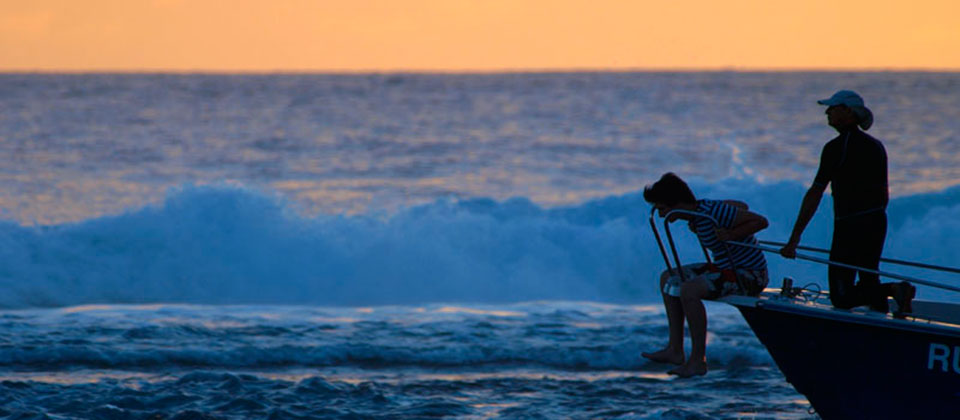Ocean Etiquette

Knowing how to interact with ocean wildlife can help you make the right decisions when you encounter wildlife. Without paying attention to how you interact in the marine environment, you are running the chance of putting endangered species, federally protected species, and thousands of other species' lives at risk.
Each time someone visits the marine environment they have the wonderful opportunity to encounter wildlife. However, the unfortunate potential to harm our marine life and resources exists with every visit. Because we love our marine resources and want you to appreciate them, the Office of National Marine Sanctuaries sees every visitor as a potential steward of our sanctuary resources. The Ocean Etiquette program calls on each of you to take on that responsibility. We have listed below a set of general marine wildlife viewing guidelines. To learn more about the Ocean Etiquette program and more specific guidelines and regulations pertaining to activity, sanctuary, or species group follow our links.
Marine wildlife viewing guidelines
Learn before you go
Read about the wildlife, viewing sites and local regulations to get the most from your wildlife viewing experience. Many species live only in specific habitats such as estuaries, coral reefs, sand dunes or the open ocean. Seasonal and daily cycles also influence when and where an animal may be located. Research on the internet, buy regional viewing guidebooks, talk with local residents and hire local guides to increase your chances of seeing marine wildlife.
Keep your distance
Use binoculars, spotting scopes and cameras with zoom lenses to get a closer look. Marine wildlife may be very sensitive to human disturbance, and if cornered, they can harm the viewer or leave the area. If wildlife approaches you, stay calm and slowly back away or place boat engines in neutral. When closer encounters occur, do not make sudden moves or obstruct the travel path of the animals - let them have the unhindered right of way.
Hands off
Never touch, handle or ride marine wildlife. Touching wildlife, or attempting to do so, can injure the animal, put you at risk and may also be illegal for certain species. The slimy coating on fish and many marine invertebrates protects the animal from infection and is easily rubbed off with a hand, glove or foot. Avoid using gloves when diving or snorkeling to minimize the temptation to touch. Remember, wild animals may bite, body slam or even pull you underwater if startled or threatened.
Do not feed or attract marine wildlife
Feeding or attempting to attract wildlife with food, decoys, sound or light disrupts normal feeding cycles, may cause sickness or death from unnatural or contaminated food items, and habituates animals to people. Habituated animals are vulnerable to vessel strikes or vandalism, and can be dangerous to people.
Never chase or harass wildlife
Following a wild animal that is trying to escape is dangerous. Never completely surround the animal, trap an animal between a vessel and shore, block its escape route, or come between mother and young. When viewing from a boat, operate at slow speed, move parallel to the swimming animals, and avoid approaching head-on or from behind, and separating individuals from a group. If you are operating a non-motorized vessel, emit periodic noise to make wildlife aware of your presence and avoid surprise.
Stay away from wildlife that appears abandoned or sick
Some marine animals, such as seals, leave the water or are exposed at low tide as part of their natural life cycle -- there may be nothing wrong with them. Young animals that appear to be orphaned may actually be under the watchful eye of a nearby parent. An animal that is sick or injured is already vulnerable and may be more likely to bite. If you think an animal is in trouble, contact the local authorities for advice.
Wildlife and pets don't mix
Wild animals can injure and spread diseases to pets, and in turn, pets can harm and disturb wildlife. For example, wild animals recognize dogs as predators and quickly flee when they see or smell dogs. If you are traveling with a pet, always keep them on a leash and away from areas frequented by marine wildlife.
Lend a hand with trash removal
Human garbage is one of the greatest threats to marine wildlife. Carry a trash bag with you and pick up litter found along the shore and in the water. Plastic bags, floating debris and monofilament line pose the greatest risk to wildlife.
Help others to become responsible wildlife watchers and tour operators
Speak up if you notice other viewers or tour operators behaving in a way that disturbs the wildlife or other viewers, or impacts sensitive habitats. Be friendly, respectful and discrete when approaching others. When operating a boat, lead by example and reduce your speed in areas frequented by marine wildlife, anchor properly and encourage others to do the same. Violations of the law should be reported to local authorities.
It's up to you!
Carry a few copies of these guidelines on your travels and share them with others. When choosing a commercial tour operator, ask if they follow these guiding principles and patronize those businesses that do. After all, protecting and conserving marine wildlife and habitats is everyone's responsibility.

